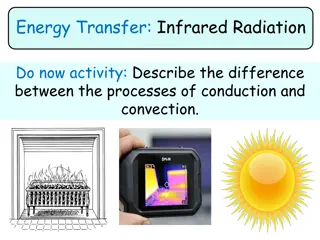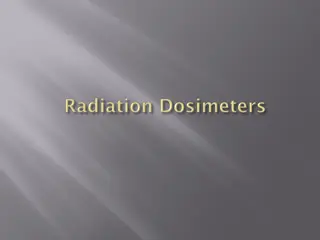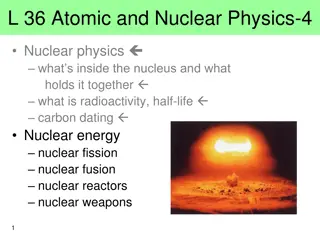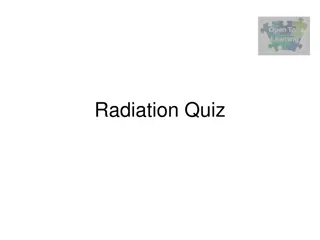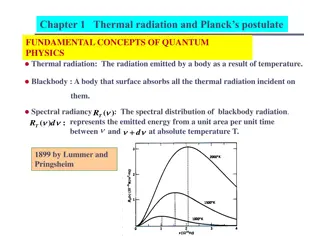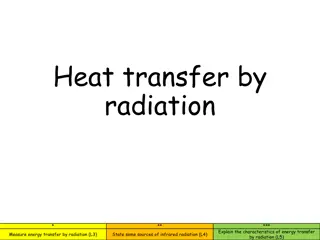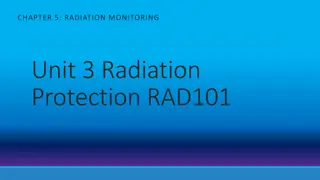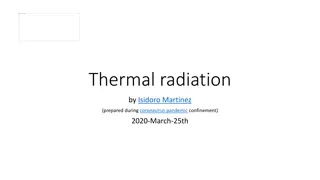Understanding Black Body Radiation: Key Concepts and Applications
Black body radiation is a fundamental concept in physics, with theoretical black bodies absorbing all radiation. While no material is a perfect black body, carbon comes close. This radiation curve demonstrates energy emission at different wavelengths, influenced by temperature variations. Stars serve as approximate black body radiators, emitting radiation across the electromagnetic spectrum. The laws of black body radiation help understand the interaction of matter with electromagnetic radiation, offering insights into celestial objects like stars.
Download Presentation

Please find below an Image/Link to download the presentation.
The content on the website is provided AS IS for your information and personal use only. It may not be sold, licensed, or shared on other websites without obtaining consent from the author. Download presentation by click this link. If you encounter any issues during the download, it is possible that the publisher has removed the file from their server.
E N D
Presentation Transcript
Mr. Sonaji V. Gayakwad Asst. professor Dept of chemistry Mrs.K.S.K. College,Beed
INTRODUCTION: A black body is a theoretical object that absorbs 100% of the radiation that hits it. Therefore it reflects no radiation and appears perfectly black. INTRODUCTION: In practice no material has been found to absorb all incoming radiation, but carbon in its graphite form absorbs all but about 3%. It is also a perfect emitter of radiation. At a particular temperature the black body would emit the maximum amount of energy possible for that temperature. This value is known as the black body radiation. A simple example of a black body radiator is the furnace. If there is a small hole in the door of the furnace heat energy can enter from the outside. Inside the furnace this is absorbed by the inside walls. The walls are very hot and are also emitting thermal radiation. This may be absorbed by another part of the furnace wall or it may escape through the whole in the door. Stars are also approximate black body radiators. Most of the light directed at a star is absorbed. It is therefore capable of absorbing all wavelengths of electromagnetic radiation, so is also capable of emitting all wavelengths of electromagnetic radiation. Most approximate blackbodies are solids but stars are an exception because the gas particles in them are so dense they are capable of absorbing the majority of the radiant energy.
The black body radiation curve (Fig1) shows that the black body does radiate energy at every wavelength. The curve gets infinitely close to the x-axis but never touches it. The curve touches at infinite wavelength. It also shows that the black body emits at a peak wavelength, at which most of the radiant energy is emitted. At 5000K the peak wavelength is about 5x10- -7 7m (500nm) which is in the visible light region, in the yellow-green section. At each temperature the black body emits a standard amount of energy. This is represented by the area under the curve.
This graph shows how the black body radiation curves change at various temperatures. These all have their peak wavelengths in the infra-red part of the spectrum as they are at a lower temperature than the previous graph. The graph shows. As the temperature increases, the peak wavelength emitted by the black body decreases. As temperature increases, the total energy emitted increases, because the total area under the curve increases.
The average or bulk properties of electromagnetic radiation interacting with matter are systematized in a simple set of rules called laws blackbody radiator radiator has very weak interaction with the surrounding environment and can be considered to be in a state of equilibrium. Although stars do not satisfy perfectly the conditions to be blackbody radiators, they do to a sufficiently good approximation that it is useful to view stars as approximate blackbody radiators. The average or bulk properties of electromagnetic radiation interacting with matter are systematized in a simple set of rules called radiation laws. These laws apply when the radiating body is what physicists call a blackbody radiator. Generally, blackbody conditions apply when the radiator has very weak interaction with the surrounding environment and can be considered to be in a state of equilibrium. Although stars do not satisfy perfectly the conditions to be blackbody radiators, they do to a sufficiently good approximation that it is useful to view stars as approximate blackbody radiators. radiation . These laws apply when the radiating body is what physicists call a . Generally, blackbody conditions apply when the
The primary law governing blackbody radiation is the Law area into a fixed direction (solid angle) from the blackbody as a function of wavelength for a fixed temperature. The Planck Law can be expressed through the following equation The primary law governing blackbody radiation is the Planck Radiation Law, which governs the intensity of radiation emitted by unit surface area into a fixed direction (solid angle) from the blackbody as a function of wavelength for a fixed temperature. The Planck Law can be expressed through the following equation. . Planck Radiation , which governs the intensity of radiation emitted by unit surface The gives a distribution that peaks at a certain wavelength, the peak shifts to shorter wavelengths for higher temperatures, and the area under the curve grows rapidly with increasing The behavior is illustrated in the figure shown above. The Planck Law gives a distribution that peaks at a certain wavelength, the peak shifts to shorter wavelengths for higher temperatures, and the area under the curve grows rapidly with increasing temperature. behavior is illustrated in the figure shown above. The Planck Law temperature.
Larger light intensity means larger number of photons at a given frequency (Energy)
The photoelectric effect provides evidence for the particle nature of light. It also provides evidence for quantization. If light shines on the surface of a metal, there is a point at which electrons are ejected from the metal. The electrons will only be ejected once the threshold frequency is reached . Below the threshold frequency, no electrons are ejected. Above the threshold frequency, the number of electrons ejected depend on the intensity of the light. The photoelectric effect provides evidence for the particle nature of light. It also provides evidence for quantization. If light shines on the surface of a metal, there is a point at which electrons are ejected from the metal. The electrons will only be ejected once the threshold frequency is reached . Below the threshold frequency, no electrons are ejected. Above the threshold frequency, the number of electrons ejected depend on the intensity of the light.





